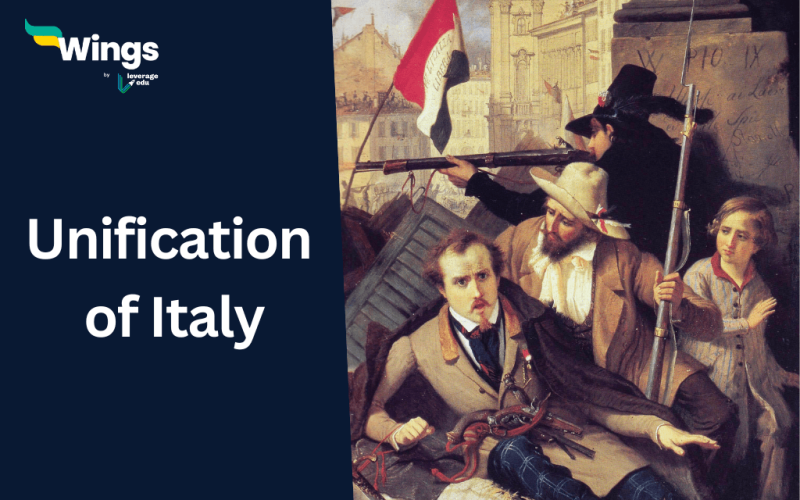Hey, guys! Mr. Owl 🦉 is here. I see that you want to know about the ‘Unification of Italy’ Hootfully, I’ll be of help to you! Since we owls are very wise. If you scroll further down this blog, you’ll see all the information you will need!
In the middle of the 19th Centruy, a political and social movement happened in Italy, that resulted in the unification of different states into a single state, known as the Unification of Italy. If you’re preparing for competitive exams, it’s crucial to have a deep understanding of such historical events. Unification of Italy is an essential portion of the history syllabus for Upcoming government exams such as UPSC, Banking, and more. These exams often contain questions related to the Unification.
Table of Contents
📍Conditions Before Unification of Italy
Before the leaders who unified Italy in 1861 created a single nation, Italy was divided into several smaller states, including Two Sicilies, Piedmont-Sardinia, Papal States, and others. Regions of Lombardy and Veneto were occupied by Austria. Below we have added a Map of Italy before Unification.

🎓What does Unification of Italy mean?
The term “Unification of Italy” refers to the process of bringing together these diverse Italian regions, each ruled by different states, to form a single, unified nation. It’s a crucial milestone in Italian history, leading to the birth of the modern Italian state.
Must Read: What Is Nationalism? Definition, History, and Significance
Events That Led to The Unification
This historic event, often referred to as the Risorgimento, was a complex process with various key events:
➡️ Napoleonic Era: Italy was conquered by Napoleonic France in 1796-1804. Napoleon’s influence modernized Italian governance.
➡️ Congress of Vienna (1815): After Napoleon’s defeat, Italian states returned to their pre-Napoleonic rulers as absolute monarchies. Austria had a significant presence in the northern regions.
➡️ Young Italy Movement: In the 1820s, groups emerged aiming to create a unified Italy. Giuseppe Mazzini founded the Young Italy movement in 1831, seeking a democratic republic.
➡️ Role of Sardinia: The Kingdom of Piedmont-Sardinia, led by figures like Prime Minister Cavour and King Victor Emmanuel II, played a pivotal role in Italian unification.
➡️ Giuseppe Garibaldi: A revolutionary and military leader, Garibaldi contributed to the unification process by organizing uprisings and supporting pro-unification movements.
Did You Know: During the Unification of Italy, a popular saying emerged: “Italy is made, now we need to make Italians.” This phrase reflects the diverse regional identities and languages present in the newly unified nation, highlighting the challenge of forging an Italian national identity.
🤵Important Personalities
Key figures instrumental in Italy’s unification:
- Giuseppe Mazzini: Founder of the Young Italy movement, advocating a democratic republic.
- Camillo Benso di Cavour: Prime Minister of Piedmont-Sardinia, a prominent Italian state, who strategically aligned with other powers.
- Giuseppe Garibaldi: A military leader who supported unification efforts through his expeditions and battles.
Also Read: Arab Nationalism: Rise, Fall and Objective
“Kiddos, I’ve answered all your queries with the utmost precision that I was capable of. Now, I’ll be taking my leave, but if you think I might have missed something, do check out the FAQ section or drop a comment. I always respond!”
FAQs
Before its unification in 1861, Italy was divided into several smaller states, each with its own rulers. Key regions were controlled by foreign powers, particularly Austria.
The unification of Italy was significant as it created a powerful European nation. Italy became the fifth most populous country in Europe, weakening Austria and strengthening France’s international standing.
Italy’s unification occurred when Piedmont-Sardinia allied with France and, in 1859, defeated Austria, which occupied parts of Northern Italy. Subsequent annexations and alliances led to the formation of the unified Italy in 1861.
RELATED BLOGS
Hope you have gotten all the relevant information about the ‘Unification of Italy’! If you want to know more about topics like this, then visit our general knowledge page! Alternatively, you can also read our blog on general knowledge for competitive exams!
 One app for all your study abroad needs
One app for all your study abroad needs













